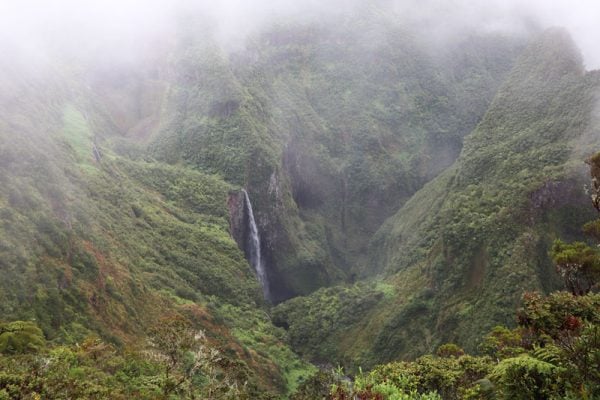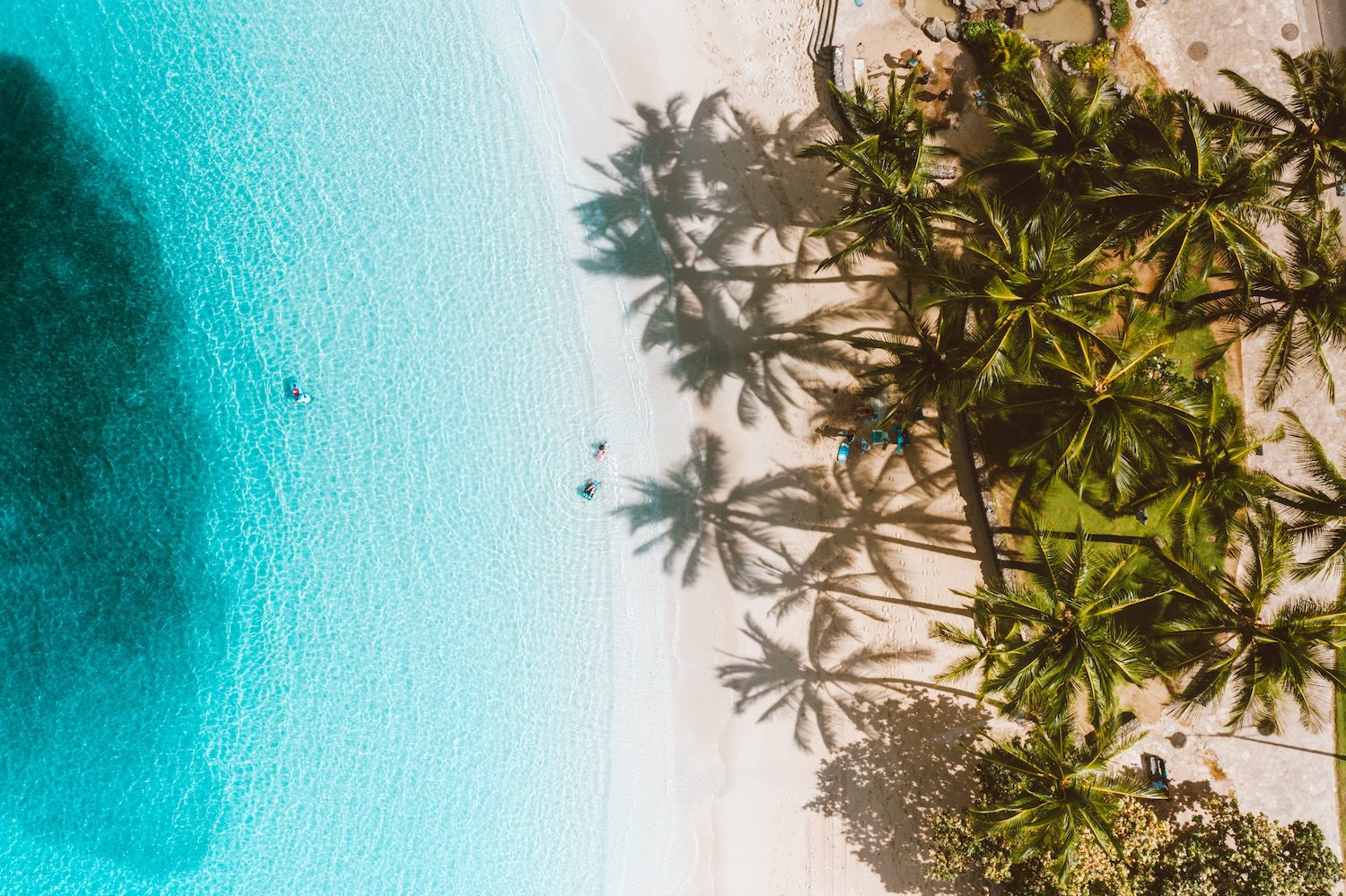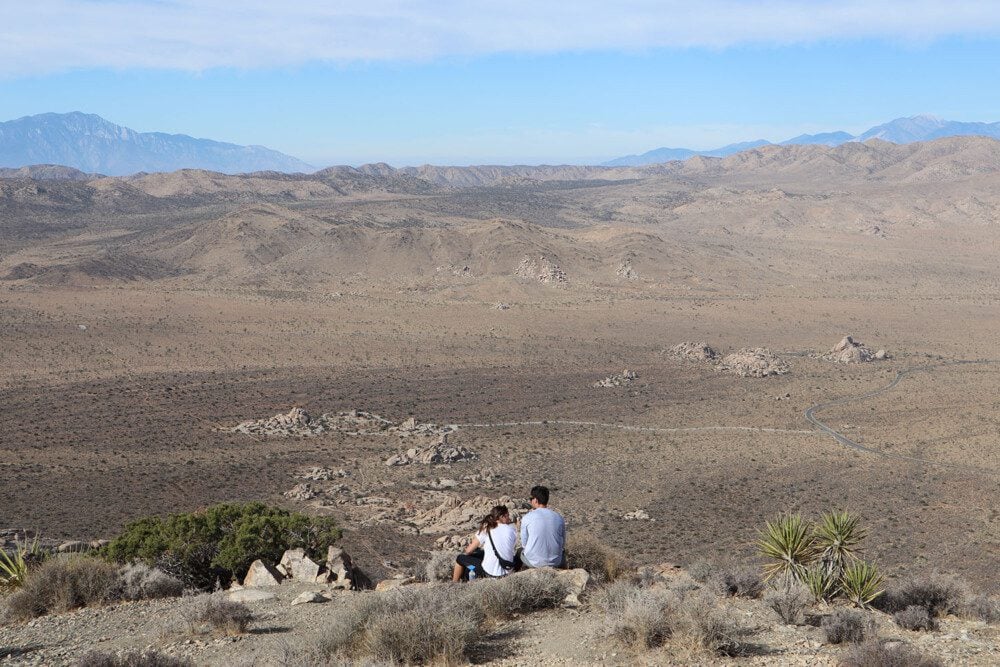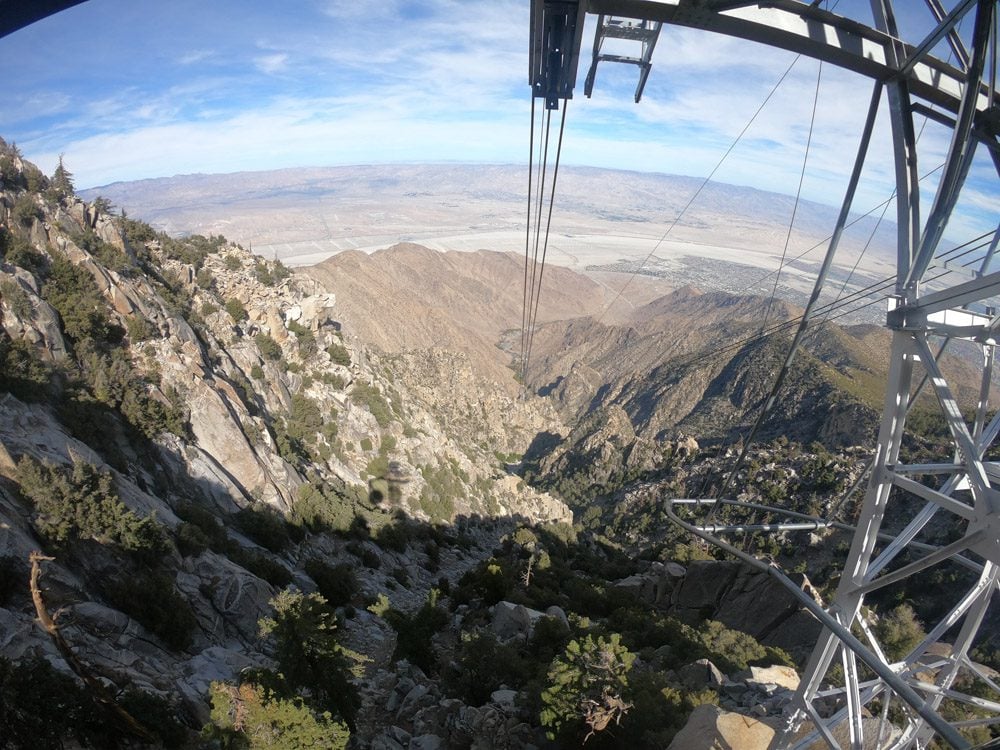Grand Canyon Travel Guide & Itinerary
A trip to the Grand Canyon comes with the understanding of just how minuscule we are in the face of Mother Nature as one stands on the edge of the rocky rim and stares at the abyss. As one of America’s most iconic natural landmarks, visiting the Grand Canyon is a right of passage for any traveler to the American Southwest. This travel guide explores the ins and outs of visiting the national park and covers a detailed itinerary for spending one or two days in the Grand Canyon.
Why Visit the Grand Canyon?

Stretching for 277 miles and extending up to 18 miles from rim to rim, one must visit the Grand Canyon to comprehend its size. And we haven’t even discussed its depth of over a mile.
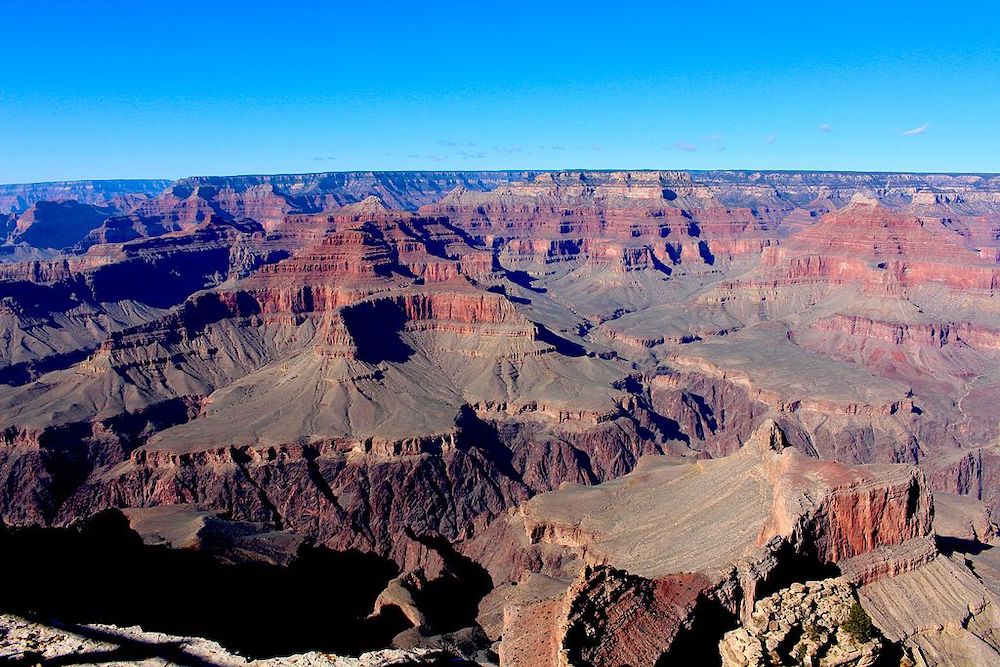
Consistently appearing on lists of the “seven natural wonders of the world,” the Grand Canyon is also one of America’s most popular national parks, and there’s a good reason why.

Hop between scenic viewpoints on the South Rim, hike to the canyon floor or join a rafting trip down the Colorado River. The Grand Canyon covers every checklist.
Two sections make up this travel guide:
- Essential Grand Canyon planning tips
- Grand Canyon itinerary: one or two days
Additional Arizona Travel Resources
Check out additional Arizona and Southwest USA travel guides to combine your visit to the Grand Canyon with additional desert highlights.

Grand Canyon Itinerary Map
All places mentioned in this Grand Canyon travel guide and itinerary are marked on this companion map. Simply click on the image to open it in Google Maps.

Grand Canyon Travel Tips
This section deep dives into the essential ingredients for a successful visit to the Grand Canyon’s South Rim.
The national park’s official website is an excellent resource for additional planning tips and the most trustworthy resource for park closures and shuttle schedules.
When is the Best Time to Visit the Grand Canyon?
The best time to visit the Grand Canyon (South Rim) is early-mid spring or mid-autumn. During these months, the temperatures are pleasant, and the crowds are fewer. It gets extremely hot and crowded in the Grand Canyon during the summer months. Some areas might not be accessible in the South Rim during the winter, and evening temperatures are cold.
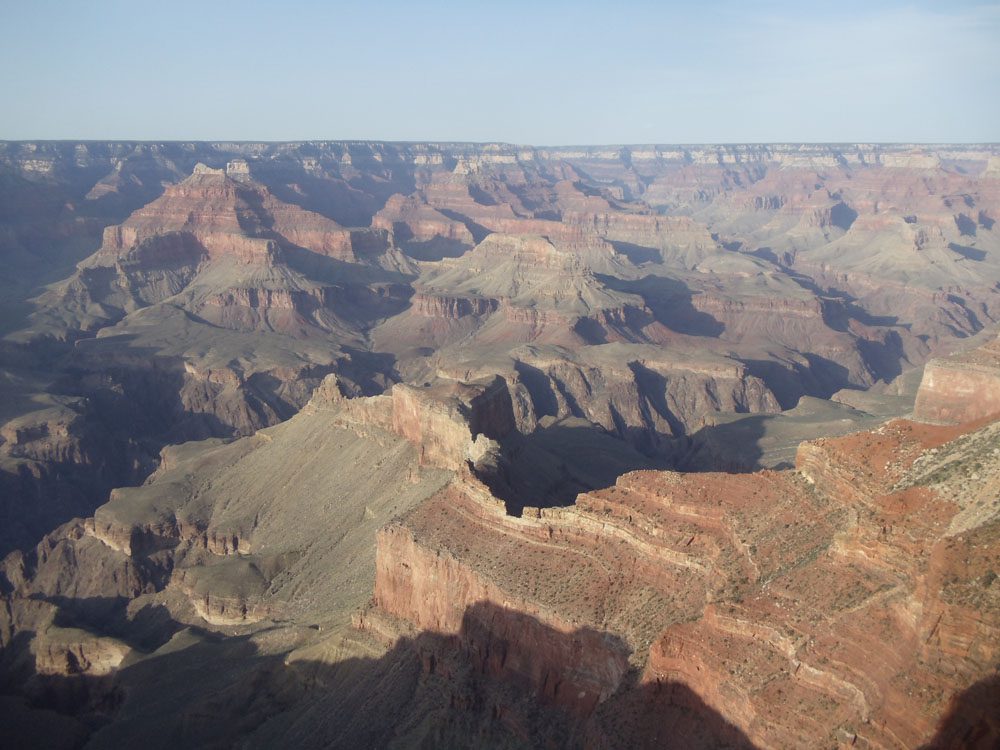
Try to avoid visiting the Grand Canyon during national and school holidays.
How Many Days Do You Need in the Grand Canyon?
On a one-day visit to the Grand Canyon (including an overnight stay), you can cover the South Rim’s top scenic viewpoints and drive the length of Desert View Drive. If you arrive early, you might also be able to squeeze in a short hike. A two-day visit to the Grand Canyon unlocks better hiking opportunities, though a third night is required if you wish to complete the Bright Angel Trail or make it to the banks of the Colorado River and back.
See the next section of this travel guide for a detailed one or two-day Grand Canyon itinerary.
North vs. South Rim
Most visitors to the Grand Canyon head to its South Rim, on the Arizona side. The South Rim is more accessible than the north rim and much more developed in terms of accommodation, transportation, and easy-to-reach sites. The South Rim is also open throughout the year, unlike the North Rim on the Utah side, which is much more remote and only gets a fraction of the visitor numbers.

Officially, only about 10 miles separate the north and south rims, but, practically speaking, 215 miles separate the two. Therefore, apart from a multi-day hike, the only way to travel between the two rims is by making a long and time-consuming detour with your car or booking a spot on the Trans Canyon Shuttle.
If you’re looking to get away from the crowds and are flexible with your itinerary, see if a Grand Canyon North Rim visit is possible.
How to Get to the Grand Canyon?
By car: the easiest way to reach the Grand Canyon’s South Rim is with a car. There are two entrance stations, the East Entrance at the far end of Desert View Drive and the South Entrance station on the Tusayan side, closer to Grand Canyon Village.
During peak season (summer months and national holidays), long queues form near the Tusayan entrance. Plan to enter the park early in the morning to avoid wasting time and to increase the chance of finding parking.
By train or plane: You can also reach the Grand Canyon “in style” either by taking the historic train from the nearby town of Williams or by flying to Grand Canyon Airport and getting a ride from there.
By public transportation: Several operators connect Grand Canyon Village with nearby hubs, most notably the town of Williams. See this website for more details.
If you’re visiting Las Vegas but not up for the long drive to the South Rim, consider joining a guided tour of the Grand Canyon from Las Vegas. Such tours leave early in the morning and cover some of the South Rim’s top viewpoints. Alternatively, save time and maximize the thrill by taking to the skies on a scenic flight from Las Vegas to the Grand Canyon.
What Else is Around the Grand Canyon?
If the Grand Canyon is just one part of a more extended desert road trip, consider the following stops.
Grand Canyon from Utah
Utah’s Zion National Park and Bryce Canyon are about five hours from the Grand Canyon by car. If you have time, spend the night in Page, on the Arizona side, and visit Antelope Canyon and Horseshoe Bend. Near Moab, Utah’s Arches National Park and Canyonlands NP are about six hours from the Grand Canyon. On the Utah-Arizona border, spend the night or a half day exploring Monument Valley.
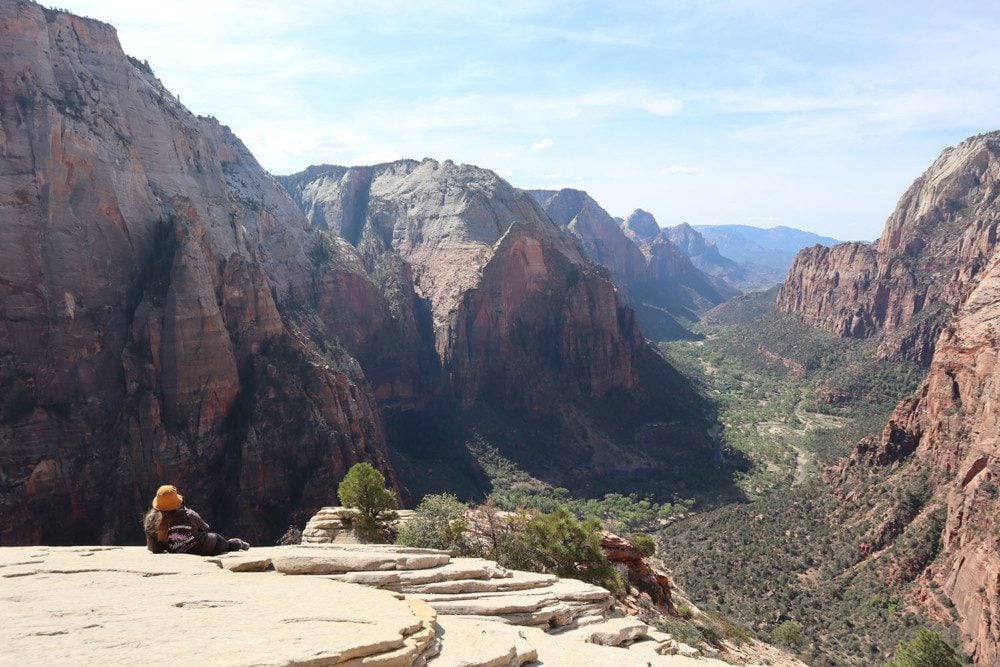
Grand Canyon from Arizona
Monument Valley is three hours northeast of the Grand Canyon. Lesser-known Canyon de Chelly is slightly further. Combine its visit with Monument Valley or drive to the Grand Canyon via Interstate 40 and Flagstaff, stopping in forgotten historic towns such as Holbrook and Winslow. If Arizona is the focus of your road trip, Sedona and its famous red-rock buttes are just two hours from the Grand Canyon. Much further south, Phoenix is 3.5 hours away, and Tucson, with nearby Saguaro National Park, is five hours south.
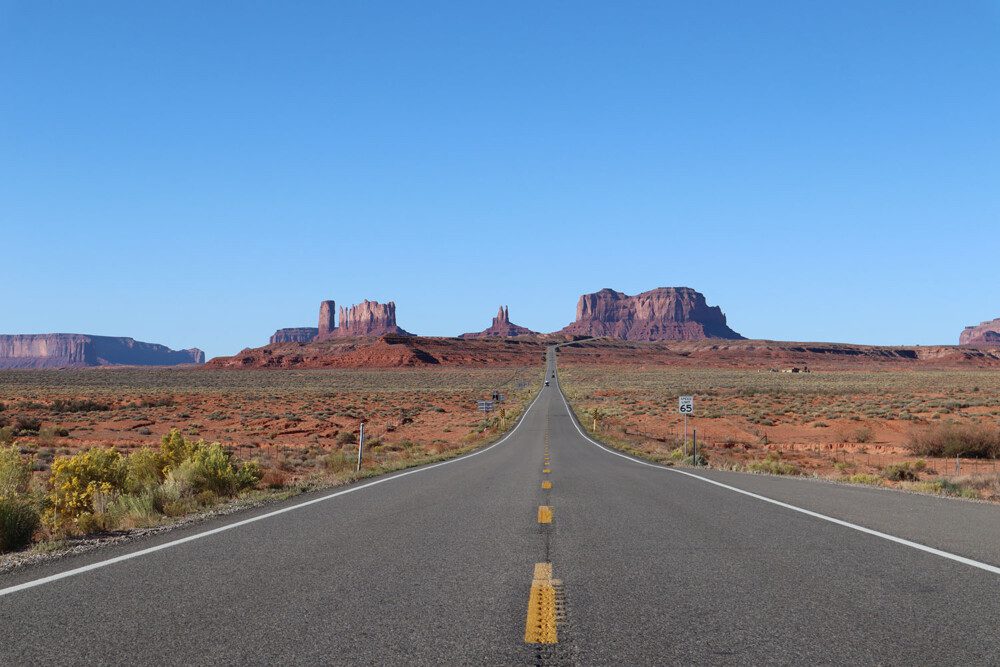
Grand Canyon from Las Vegas & California
If you’re starting your road trip in California, spend a couple of nights in Palm Springs or near Joshua Tree National Park. Then, spend a day exploring Mojave National Preserve and a couple of nights in Death Valley. After one or two nights in Las Vegas, drive to the Grand Canyon via one of the best stretches of old Route 66 between Kingman and Seligman.

If you’re visiting Las Vegas but can’t make it to the Grand Canyon’s South Rim, consider joining guided tours to the Grand Canyon West. This newly developed tourist area is located within the Hualapai Indian Reservation. Its most famous attraction is the engineering marvel known as the Skywalk. You can also join rafting tours down the Colorado River and take to the skies on scenic flights.
Advanced Reservations
At the time of writing this Grand Canyon travel guide and itinerary, apart from entrance fees, no advanced reservations are necessary for entering the South Rim or for day hikes. However, due to increasing visitor numbers, this might change in the future.
If you’re planning to visit multiple national parks, purchase the America the Beautiful Pass and save on national park fees.
Where to Stay in the Grand Canyon?
The Grand Canyon is one of America’s most visited national parks, so securing your accommodation as far in advance as possible during peak months is essential.
Lodging inside the park: the historic El Tovar Hotel is the most luxurious accommodation option in the Grand Canyon. The hotel is located near the South Rim, with simpler nearby options such as Bright Angel Lodge, Kachina Lodge, Thunderbird Lodge, and Maswik Lodge. The Yavapai Lodge is another option. It’s located slightly closer to the visitor center, and its large complex accommodates more guests than other lodges.

Lodging outside the park: serviced by free shuttle buses during peak months, Tusayan is the gateway town to the Grand Canyon. Beyond Tusayan, Grand Canyon Junction is your next best option, followed by towns along Interstate 40.
Camping: the National Park Service operates four official campgrounds accessible to cars, some of which are seasonal. Due to high demand, make advanced reservations where possible. Apart from backcountry camping within the national park, you’ll find additional campgrounds along both ends of Highway 64.
(1) Here are all Grand Canyon accommodations that can be booked online via Booking.com. (2) If you’re visiting the Grand Canyon on a day trip, spend the night before as close as possible to the national park to beat the crowds and to maximize your sightseeing time.
Getting Around the Grand Canyon
The best way to get around the Grand Canyon’s South Rim is by using a mix of private cars and park shuttles. Use your vehicle to drive part of or the entire length of Desert View Drive and use the park’s free shuttles to explore the area west of the visitor center and reach the South Kaibab Trailhead or Yaki Point. Seasonal park shuttles also connect Tusayan with Grand Canyon Village.
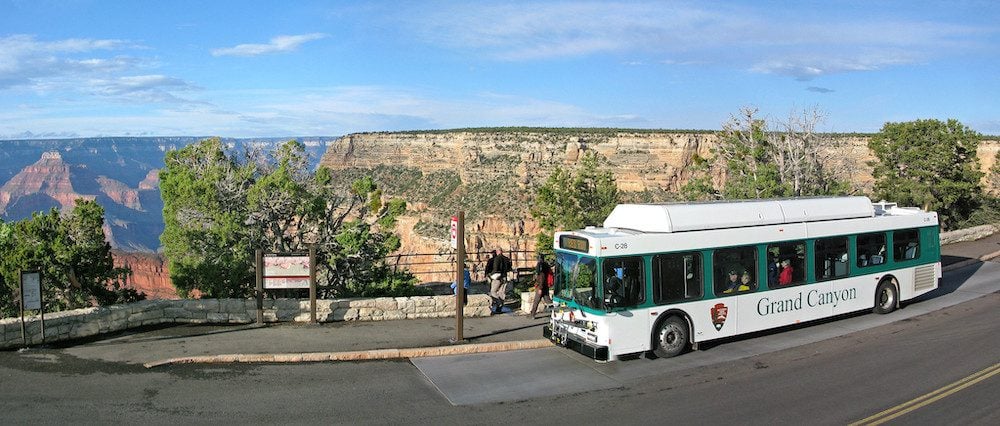
(1) You can also rent a bike in the Grand Canyon and cycle along the South Rim. (2) Use the Grand Canyon Rim Trail to skip some of the shuttle stops and walk between the scenic viewpoints.
Mobile Reception in the Grand Canyon
There should be good mobile reception in and around the commercial centers along the South Rim. However, I recommend downloading an offline map to your phone, so you can navigate to points of interest even without a signal.
What to Pack for the Grand Canyon
Here are a few items worth considering when planning a trip to the Grand Canyon. This is not an exhaustive list.

- The Lonely Planet Guide to the Grand Canyon is a comprehensive resource for travelers. If the Grand Canyon is part of an extended road trip, get your copy of the Lonely Planet guide to Southwest USA.
- Hydration backpack: a daypack that also holds a water bag.
- Sun protection: hat, sunscreen, sunglasses
- Clothing: lightweight and sweat-repelling layers but also multiple warm layers for cool mornings and evenings.
- Extra warm clothing if visiting outside the summer months, including gloves, and a warm hat.
- Dry weather: lip balm, tissues, hand cream.
- Safety: first-aid kit, walking poles (recommended if hiking), hiking shoes, thick socks
- USB charger to charge your phone in the car
- Snacks, picnic gear, etc.
- Waterproof gear if joining a rafting tour.
Grand Canyon Itinerary
In this section, we’ll explore an itinerary for spending one or two days in the Grand Canyon.
Day 1: Desert View Drive & Hermit Road
If you only have one day to spend in the Grand Canyon, invest the time in walking and driving along the South Rim to take in the majestic canyon views. Get an early start and beat the crowds by entering the national park early in the morning.
To fully grasp the immense dimensions of the Grand Canyon, take to the skies in a scenic helicopter flight and fly over the widest and deepest sections of the canyon. Scenic flights are just under one hour and depart from Tusayan.
The Visitor Center
Most visitors enter Grand Canyon National Park from the south entrance. Continue along South Entrance Road and park near the visitor center. Chat with the friendly park rangers, “sanity check” your itinerary, and pick up key informational brochures such as shuttle schedules. Also, see if any special ranger-led programs are taking place and adjust your itinerary accordingly.
You can also enter the Grand Canyon from the eastern tip of Desert View Drive. If you enter from this end, stop for a chat with rangers at one of the information desks.
Desert View Drive
Desert View Drive is a scenic road stretching 23 miles (37 km) from the visitor center to the east entrance. The road is part of State Route 64, but it’s branded as Desert View Drive. It’s the only section along the South Rim that’s open to private vehicles. You can drive the entire length of Desert View Drive or visit a few worthwhile viewpoints before returning to Grand Canyon Village and the visitor center.
The first stop along the scenic drive is at Shoshone Point, and it’s optional only because you can’t drive to the viewpoint itself. Park your car and pick up the short and easy Shoshone Point Trail to reach the viewpoint. Because it’s accessed only on foot, Shoshone Point doesn’t get as crowded as other viewpoints and it’s well worth the effort.
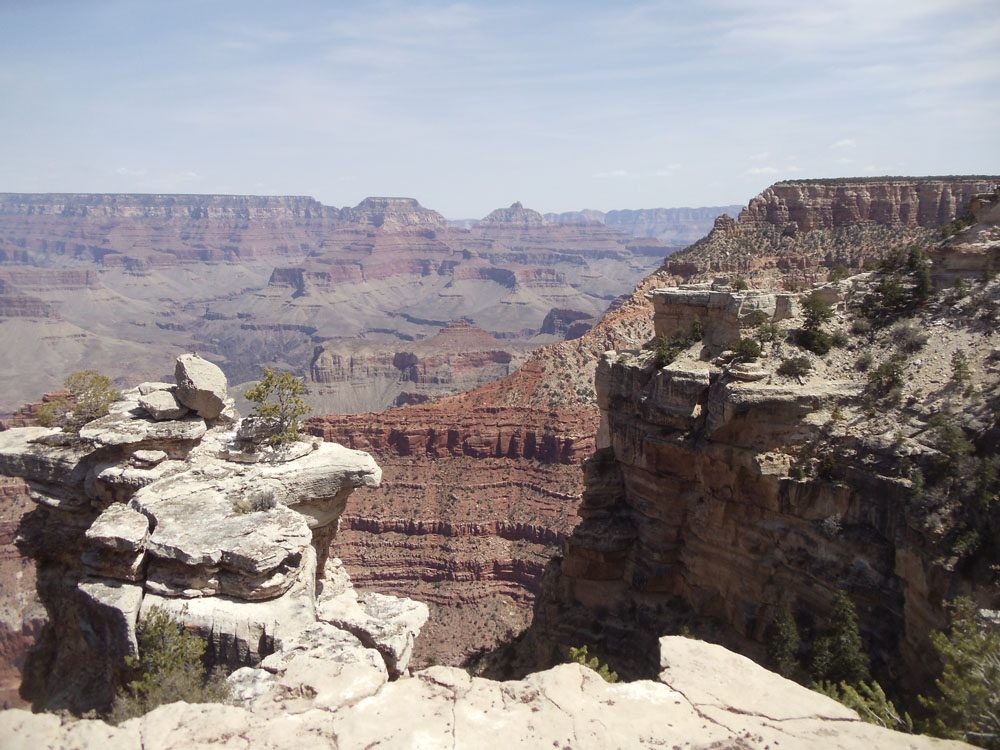
Back in the car, head to Grandview Point next, and catch your first glimpse of the Colorado River. There’s also a lot of history behind Grandview Point, as it’s the birthplace of tourism in the Grand Canyon. Before the construction of the railway from Williams, visitors would cluster around Grandview Point and its facilities.
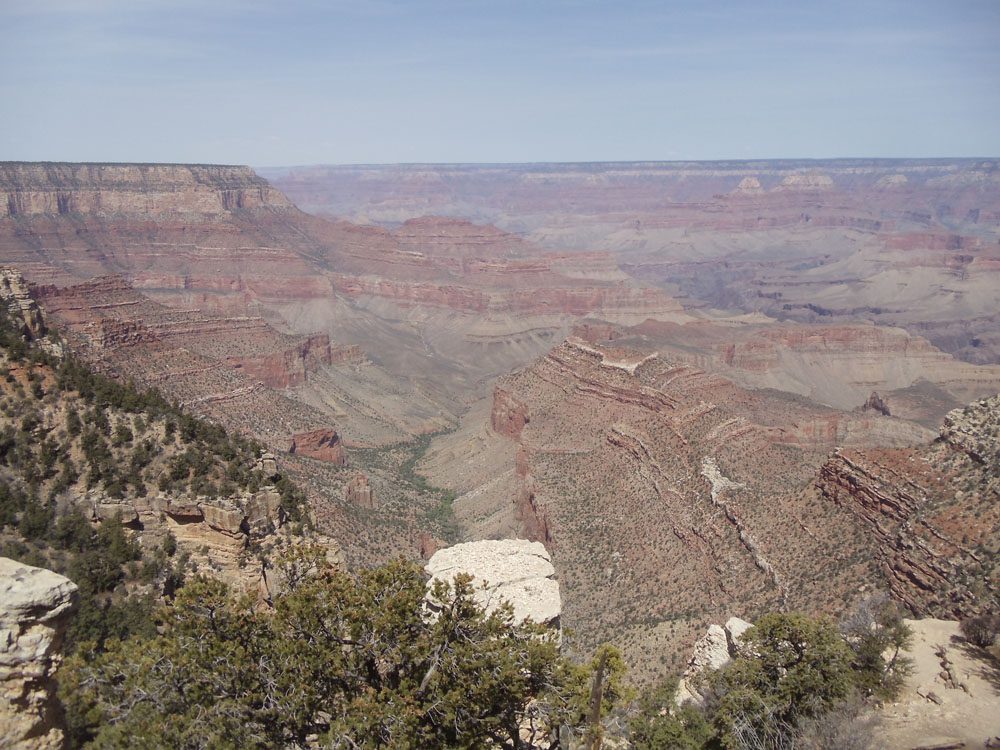
The Grandview Trail Loop begins at this scenic viewpoint. It’s a challenging and long hike, but you can hike part of it down to Horseshoe Mesa either today or tomorrow.
From Grandview Point, continue to additional scenic spots. At Moran Point, see the sediment layers that make up the South Rim. At Tusayan Pueblo Site, visit the remains of an Ancestral Puebloan structure and a modest museum. Try spotting the Hance Rapid at Lipan Point, and at Navajo Point, catch distant views of the Desert View Watchtower. Finally, at Desert View Point, stop for a picnic lunch or a coffee break. Then, walk to the watchtower and enjoy some of the best Colorado River views along the South Rim.
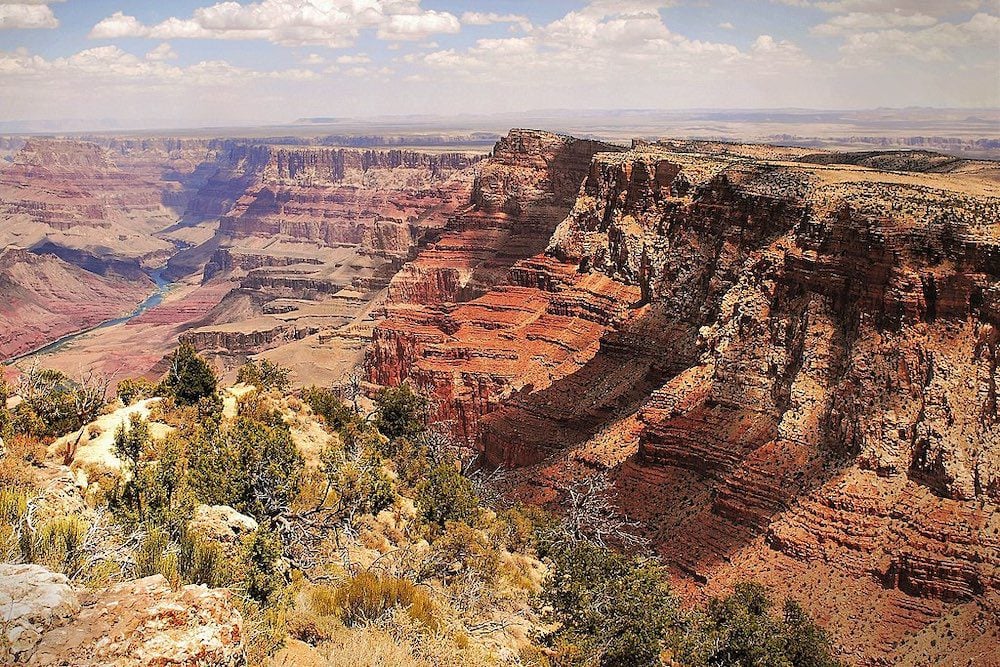
Yaki Point
Back at the visitor center, it’s time to ditch the car for the remainder of the day and use the free park shuttles to get around. Use the orange shuttle line to reach Yaki Point. Along the way or on the return leg, stop at busy Pipe Creek Vista for a pretty view of the canyon in which the South Rim appears trapped between Yaki Point and Mather Point. Get back on the shuttle bus from Pipe Creek Point or hike on the Grand Canyon Rim Trail to Yaki Point. This popular viewpoint offers sweeping views of the canyon.
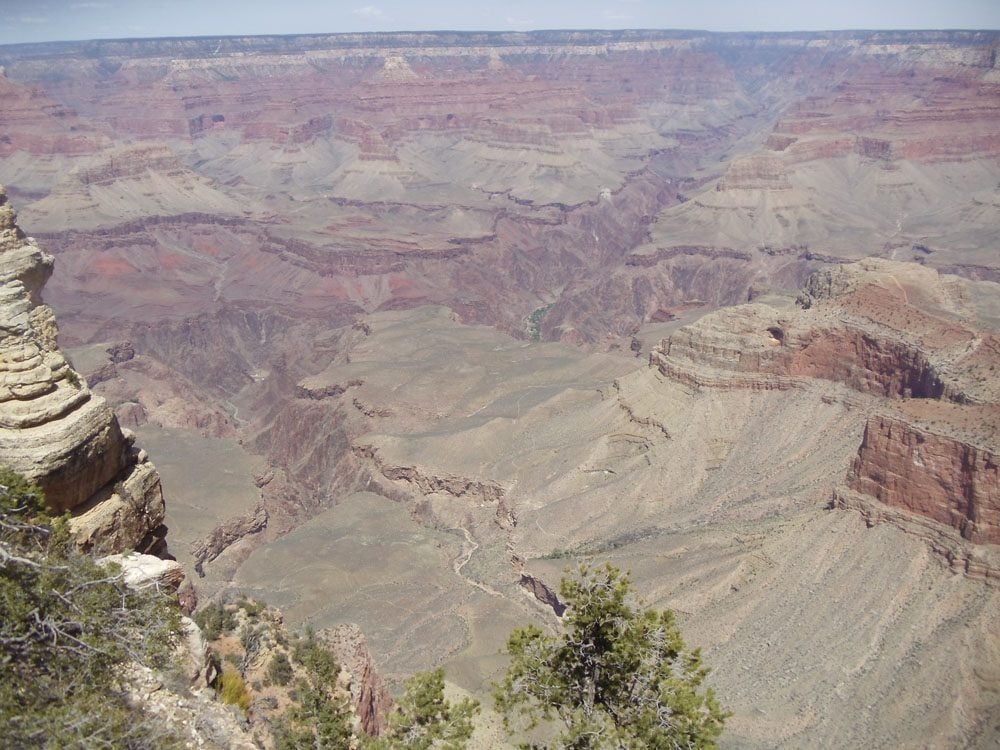
Mather Point & Yavapai Point
Back at the visitor center, walk to Mather Point and enjoy some of the best views of the Grand Canyon from the South Rim. As one of the most accessible viewpoints in the national park, the viewing area at Mather Point is always busy.
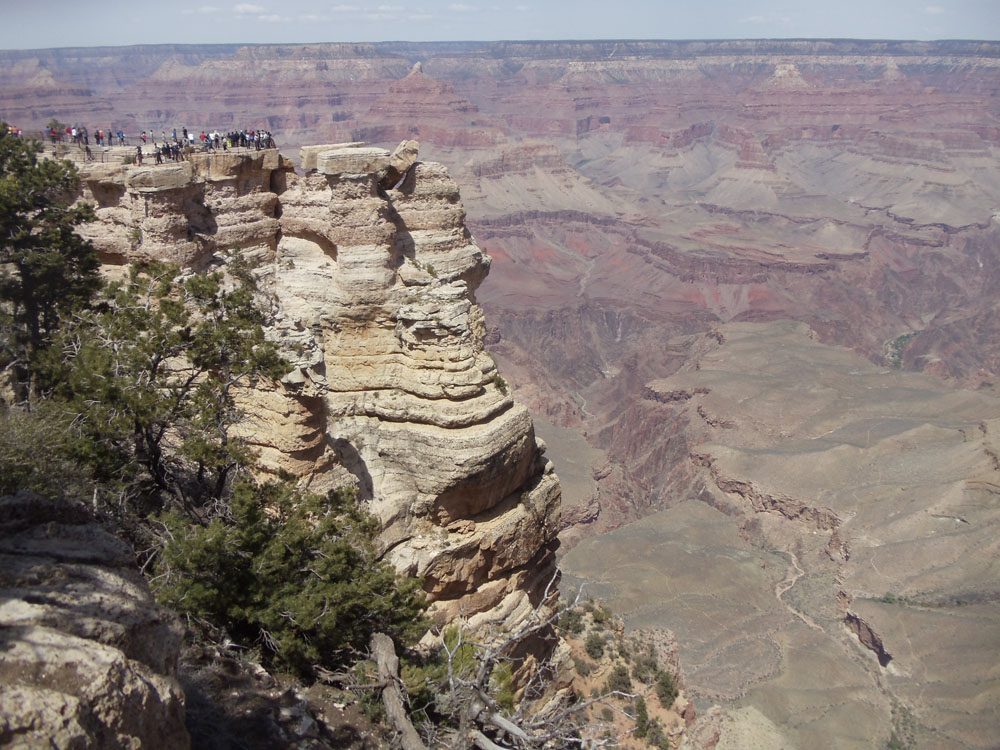
From Mather Point, walk along the Rim Trail to Yavapai Point. This viewpoint offers long range views of the canyon and its floor, including the Colorado River. If you’re curious about how the Grand Canyon formed, head to the Yavapai Observation Station.

Grand Canyon Village
From Yavapai Point, head back to the visitor center and take the blue shuttle line to Grand Canyon Village. Alternatively, you can walk along the South Rim from Yavapai Point to the canyon’s historic center. This is an optimal spot for a lunch break in one of the village’s restaurants or cafeterias. Alternatively, find an empty bench and enjoy a picnic lunch with memorable canyon views.
Grand Canyon Village is the park’s commercial center, and it’s also home to the railway station. If you’re pressed for time, there’s no need to explore the various museums and displays along the rim, but it’s worth checking out the impressive interior of the historic El Tovar Hotel.
Hermit Road
We’ll wrap up the day by visiting the exceptional viewpoints along Hermit Road, the park’s western section beyond Grand Canyon Village. Get around using the red shuttle line, which stretches for eight miles between the edge of the village and Hermit Trailhead.
You can also use the rim trail together with the red shuttle line to spice things up.
At Trail View Overlook, get off the shuttle and see the notorious switchbacks of the Bright Angel Trail. Depending on your timing, you’ll see excited hikers heading down to the Colorado River or exhausted hikers counting the steps left to reach the flat canyon rim.

Next up is Maricopa Point, with its superb panoramic views of the canyon. At Powell Point, see the memorial commemorating the first expeditions to the region and skip Hopi Point, as we’ll return here later to catch the sunset. Stop at Mohave Point if you’re still craving long-range canyon views, but don’t miss The Abyss, where a 3000-foot chasm plunges to the canyon floor. If it’s not too late by now, continue to Pima Point for some of the best Colorado River views and on to Hermit’s Rest to see its cabin-like interior.
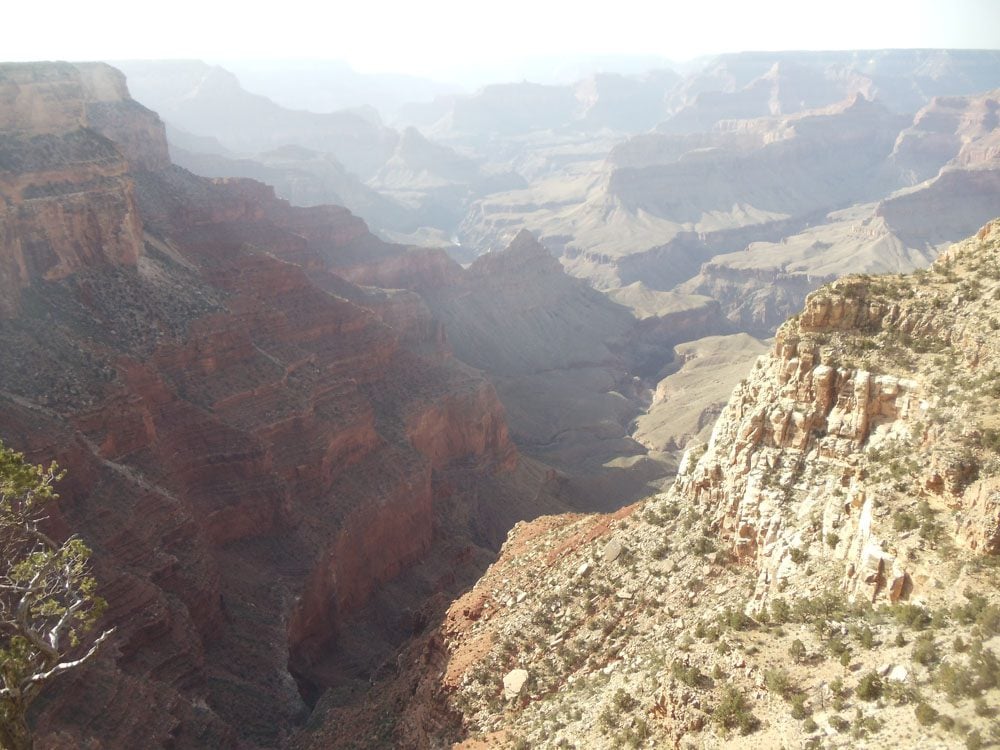

Sunset at Hopi Point
Wrap up the sightseeing portion of this busy day with a glorious sunset at Hopi Point. This is one of the best places to watch the sunset at the Grand Canyon, and it’s certainly no secret so arrive early to grab your spot, and don’t forget to pack something warm just in case.
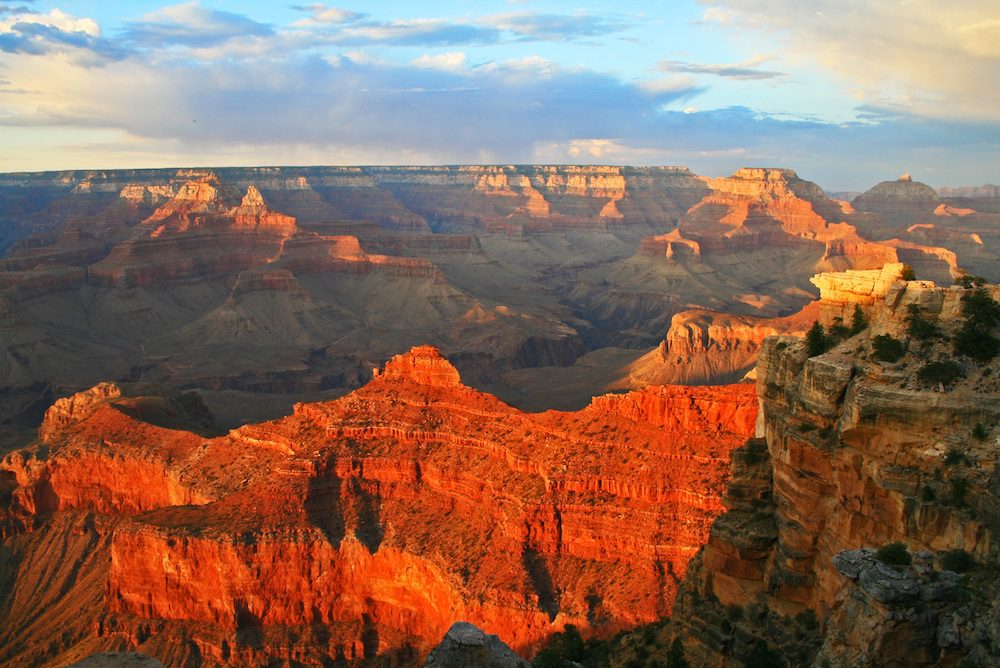
Dinner in Grand Canyon Village
Celebrate an action-packed first day with dinner at Arizona Steakhouse in the Bright Angel Lodge or go upscale and dine at the El Tovar Hotel (reservations are recommended for both options). Otherwise, eat near your hotel outside the park or in one of the casual eateries near your lodge.
Day 2: Hiking in the Grand Canyon
We’ll spend the last day on this Grand Canyon itinerary attempting to hike to its floor on one of the park’s challenging trails. Depending on the length of your chosen hike, you should be able to leave the national park in the afternoon en route to your next destination.
(1) Check trail conditions, hazards, and general safety tips with park rangers. (2) If you want to catch the sunrise over the Grand Canyon, get an early start and head to Yavapai Point.
If the challenging hikes are out of the question, but you still want to plunge to the canyon floor, consider joining a guided mule ride in the Grand Canyon. Several options are available, but advanced reservations are a must.
Bright Angel Trail
The Bright Angel Trail is the Grand Canyon’s most famous hiking trail. It begins in Grand Canyon Village and ends in the Colorado River. It is not feasible for most hikers, nor is it recommended to attempt hiking the entire length of the Bright Angel Trail in a single day. Instead, hike to one of the trail’s two rest stops (at 1.5 and three miles), or Havasupai Gardens (formerly known as the Indian Garden). If you started very early in the day, you might be able to reach scenic Plateau Point, but it will be a long and hard climb back to the South Rim.

South Kaibab Trail
If the ten percent grade of the Bright Angel Trail isn’t challenging enough for you, the South Kaibab Trail is the quickest way to reach the river from the South Rim. This trail doesn’t get as busy as the Bright Angel Trail and requires using the orange shuttle line to reach its trailhead. Depending on your fitness level and time, you can hike sections of this trail. At Ooh-Aah Point, enjoy spectacular canyon views as it opens up beyond Yaki Point. Then, overcome the switchbacks to reach Cedar Point and either turn around or continue to Skeleton Point to catch your first views of the Colorado River.
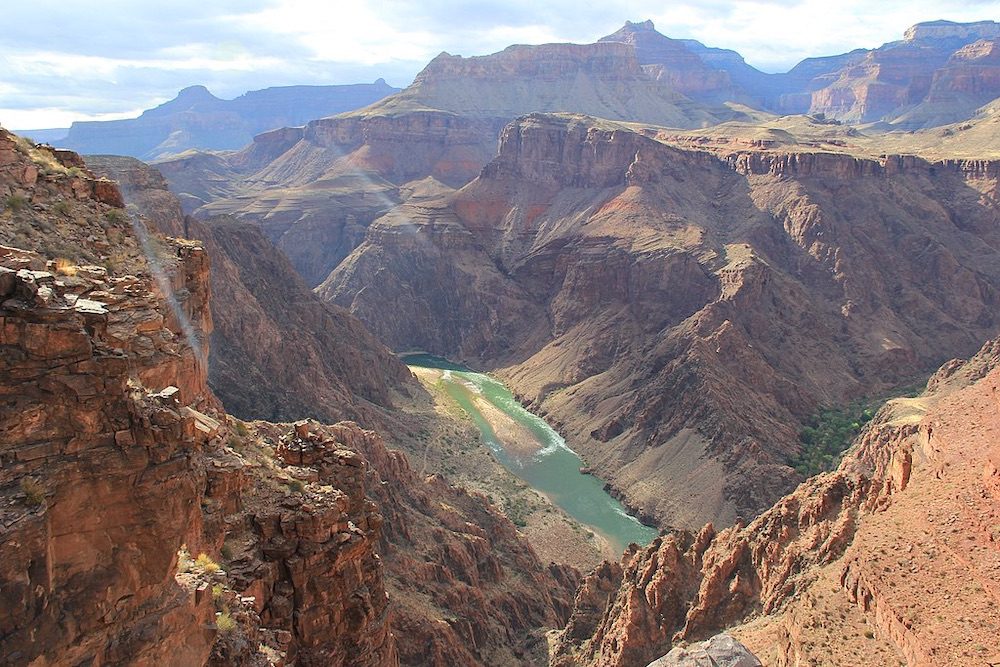
Hermit Trail
The Hermit Trail was constructed in 1911. It steeply drops for the first 2.5 miles and is considered more challenging than the Bright Angel and South Kaibab trails. In addition, the Hermit trail leads to several springs.
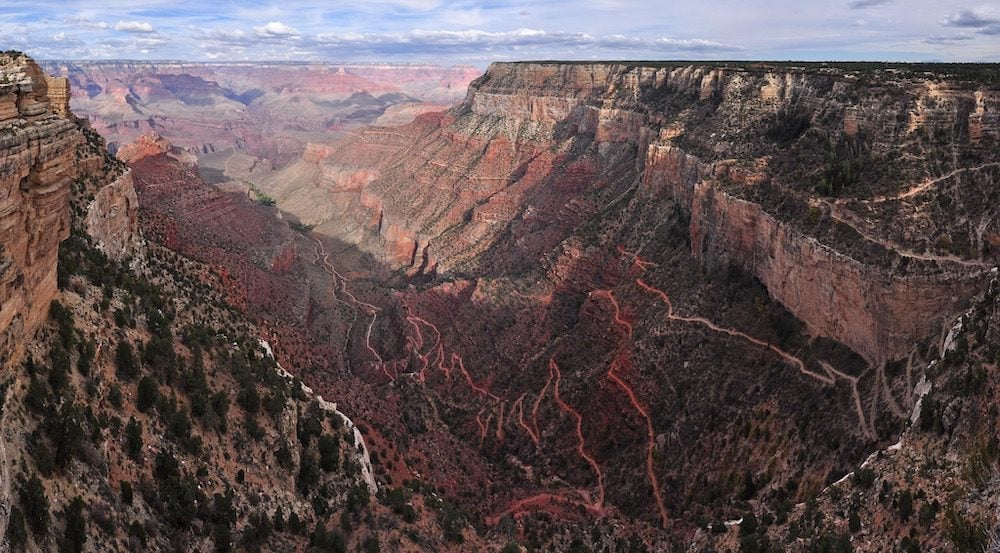
Grandview Trail
The Grandview Trail is accessed from Grandview Point on Desert View Drive. It’s another challenging day hike where you’re exposed to the elements and must hike with caution. The trail was built in 1893 as a mining route, ending at Horseshoe Mesa for a 6.5-mile roundtrip hike.
What’s Next?
With this Grand Canyon travel guide and itinerary, you’re now ready to plan your visit to the Southwest’s most prized natural gem. If you’re spending one day in the Grand Canyon, focus on the South Rim’s best viewpoints. If you’re spending two days in the Grand Canyon, don’t put your legs to work too much on day one, as this day is all about hiking down from the rim and back up. Be sure to check out additional Arizona, Utah, and Southwest USA travel guides, and plan the next legs of your adventure in the American Southwest.

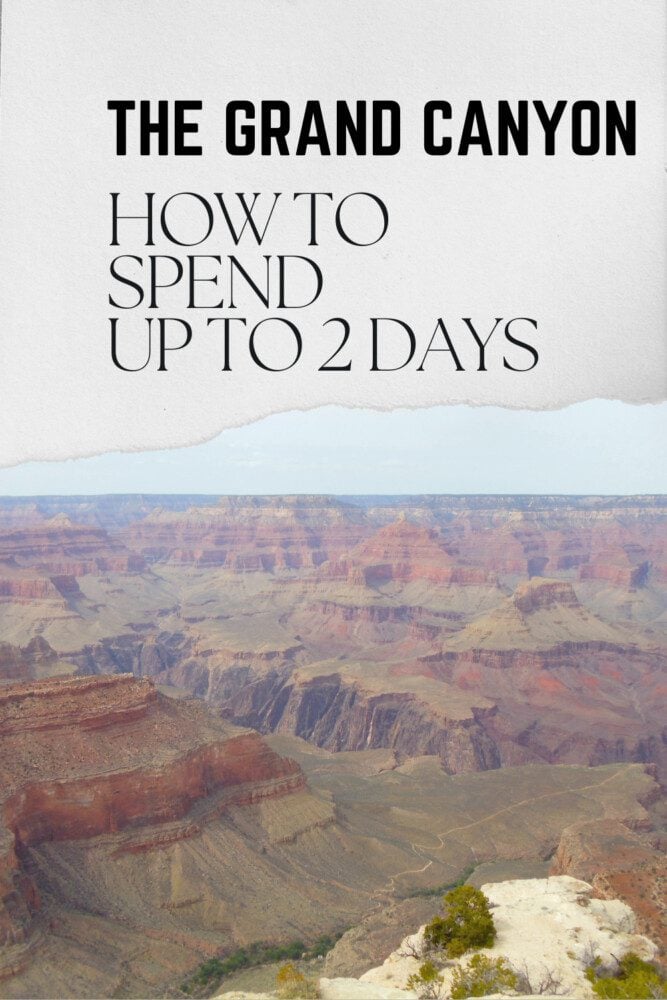
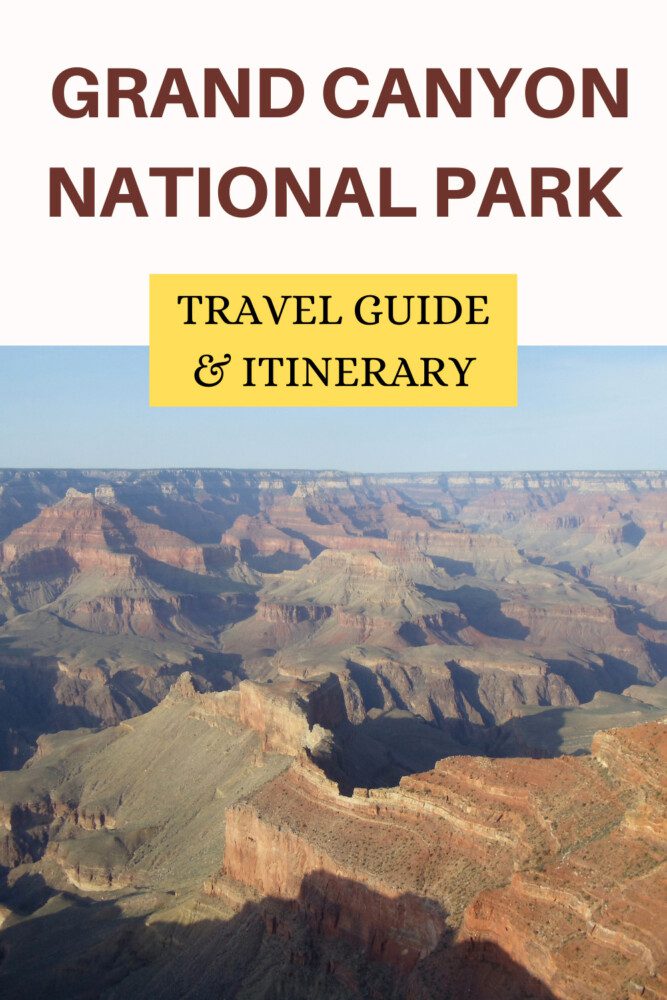
Pin These Images To Your Favorite Boards!




